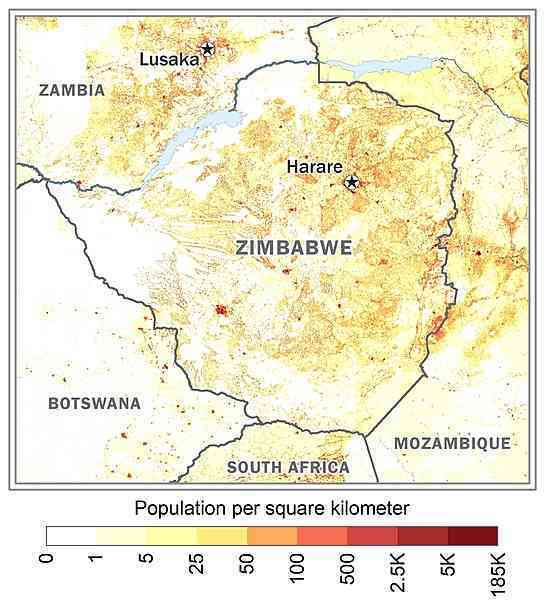
Southern Africa, between South Africa and Zambia
20 00 S, 30 00 E
Africa
total: 390,757 sq km
land: 386,847 sq km
water: 3,910 sq km
about four times the size of Indiana; slightly larger than Montana
total: 3,229 km
border countries (4): Botswana 834 km; Mozambique 1,402 km; South Africa 230 km; Zambia 763 km
0 km (landlocked)
none (landlocked)
tropical; moderated by altitude; rainy season (November to March)
mostly high plateau with higher central plateau (high veld); mountains in east
highest point: Inyangani 2,592 m
lowest point: junction of the Runde and Save Rivers 162 m
mean elevation: 961 m
coal, chromium ore, asbestos, gold, nickel, copper, iron ore, vanadium, lithium, tin, platinum group metals
agricultural land: 42.5% (2018 est.)
arable land: 10.9% (2018 est.)
permanent crops: 0.3% (2018 est.)
permanent pasture: 31.3% (2018 est.)
forest: 39.5% (2018 est.)
other: 18% (2018 est.)
1,740 sq km (2012)
Zambezi (shared with Zambia [s]), Angola, Namibia, Botswana, and Mozambique [m]) - 2,740 km; Limpopo (shared with South Africa [s], Botswana, and Mozambique [m]) - 1,800 km
note – [s] after country name indicates river source; [m] after country name indicates river mouth
Indian Ocean drainage: Zambezi (1,332,412 sq km)
Internal (endorheic basin) drainage: Okavango Basin (863,866 sq km)
Upper Kalahari-Cuvelai-Upper Zambezi Basin
Aside from major urban agglomerations in Harare and Bulawayo, population distribution is fairly even, with slightly greater overall numbers in the eastern half as shown in this 
recurring droughts; floods and severe storms are rare
landlocked; the Zambezi forms a natural riverine boundary with Zambia; in full flood (February-April) the massive Victoria Falls on the river forms the world's largest curtain of falling water; Lake Kariba on the Zambia-Zimbabwe border forms the world's largest reservoir by volume (180 cu km; 43 cu mi)
NOTE: The information regarding Zimbabwe on this page is re-published from the 2024 World Fact Book of the United States Central Intelligence Agency and other sources. No claims are made regarding the accuracy of Zimbabwe 2024 information contained here. All suggestions for corrections of any errors about Zimbabwe 2024 should be addressed to the CIA or the source cited on each page.
This page was last modified 04 May 24, Copyright © 2024 ITA all rights reserved.